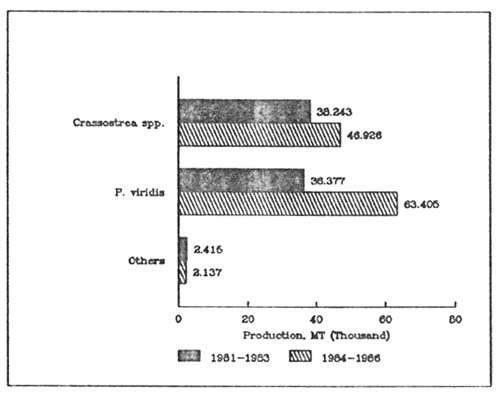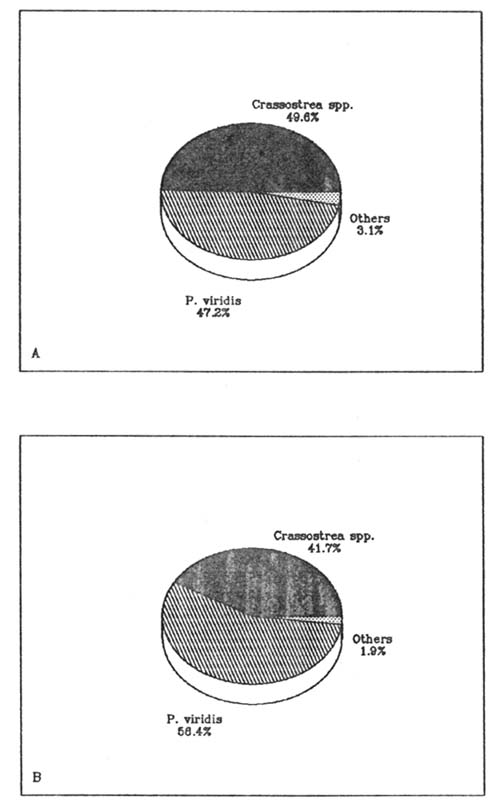Total annual shellfish production output from 1980 to 1986 are shown in Figure 1. Production in 1980 amounted only to 3,766 MT but jumped to over 400% in the following year mainly due to a sharp increase in the production of oysters and green mussel. Mollusc landings from 1981 (19,563 MT) to 1985 (42,170 MT) increased steadily at an average annual growth rate of 21%. Total production in 1986 declined to 32,860 MT mainly due to the decline in oyster and mussel (Crassostrea spp. and Perna viridis) production.
Table 1 shows the most important mollusc species cultured in the
Philippines along with their annual production figures from 1980
to 1986.
Various species of oysters are found in almost the entire coastal
areas of the country and they are particularly abundant in bays
and estuaries that have some runoff from the land. Four species
of oysters are cultured, the slipper-shaped oyster Crassostrea
iredalei, the subtrigonal oyster C. malabonensis and the curly or
palm rooted oysters C. palmipes and Saccostrea cucullata. The
species receiving particular attention in terms of culture are C.
iredalei and the moderately sized C. malabonensis. They are
particularly abundant in Bacoor Bay and extend to the entire
Manila Bay from Tarnate, Cavite to Mariveles, Bataan, along the
coast of Northern Luzon, Lingayen Gulf, Tayabas and Sorsogon; and
to some extent in Batangas Bay, Banate Bay in Iloilo, Binalbagan,
Hinigaran and Himamaylan, Negros Occidental, and in areas around
Catbalogan, Western Samar, Northern Leyte and Palawan.
Commercial farming however tends to concentrate along the coast
of various provinces largely in Bulacan, Capiz, Cavite,
Pangasinan, Sorsogon and Negros Occidental. The highest output
during the last few years occurred in 1982 with a production of
19,017 MT but dropped to 11,469 MT the following year. From 1983
to 1986 there has been an annual growth rate of about 36 %. The
total area of oyster farms in operation in 1986 was 467 hectares
in contrast to the 707 hectares the previous year (Malig and
Edra, 1987). Such decline has been attributed to the rising
production costs and slack demand due mainly to the poor sanitary
quality of the product.
There are three species of mussels in the Philippines which are
used as food: the green mussel Perna viridis, the brown mussel
Modiolus metcalfei and M. philippinarum. The green mussel or
“tahong” as it is locally known is the only species of mussel
farmed commercially in some areas in the Philippines. The brown
mussel, although they are harvested from natural grounds, are not
suitable for farming because it is not known to attach to ropes
or bamboo poles, but only on living adults growing in dense mats
on muddy bottoms.
Perna viridis has a restricted distribution in the Philippines.
They are mainly found in Bacoor and Manila Bays in Luzon as well
as in Sapian Bay in West Visayas, Magueda Bay in East Visayas and
in a number of bays and inlets along the northern coast of Panay
Island. The brown mussel, on the other hand, is widely
distributed, occurring in Luzon, most Visayan islands and
Mindanao.
In the Philippines, mussels were originally regarded as a pest by
oyster farmers and bamboo fish-trap operators in Cavite as they
competed with oysters for food and space. It was only in the
early 1950's that their value as a primary crop was recognised.
The earliest record of a commercial mussel farm dates back to
1955. It was not until 1959 that another farm was established,
and since then the industry has proliferated.
Mussel farming is being done on a commercial scale in Manila Bay,
Bacoor Bay (Cavite), Sapian Bay (Capiz) and Maqueda Bay (Samar).
Production of the green mussel has increased since early 1980's
with the highest annual production of 26,154 MT in 1985 and an
average annual growth rate of 84%. Production in 1986 dropped
to 15,719 MT.
Other important bivalves in the Philippines include cockle
(Anadara spp.), scallop (Amusium sp.) and the carpet clam (Paphia
sp.). In 1986 their combined production amounted to 95 MT,
considerably lower than the 499 MT produced in the previous year,
mainly due to the reduction in the production of the carpet clam
and scallop.
Abalone production (Haliotis sp.) in the Philippines is also
important. Yearly production in the early 1980's averaged about
100 MT, however only 67 MT was produced in 1986.

Figure 1. Total annual production of commercially important molluscs in the Philippines from 1980 to 1986.

Figure 2. Total production figures for the periods 1981–1983 and 1984–1986 of the major mollusc species in the Philippines.
Table 1: Annual production of commercially important shellfish in the Philippines, 1980–1986. (Values: MT).
| SPECIES | YEAR | ||||||
|---|---|---|---|---|---|---|---|
| 1980 | 1981 | 1982 | 1983 | 1984 | 1985 | 1986 | |
| Crassostrea spp. | 46 | 7,757 | 19,017 | 11,469 | 14,776 | 15,485 | 16,665 |
| Perna viridis | 3,258 | 10,835 | 6,475 | 19,067 | 21,532 | 26,154 | 15,719 |
| Anadara spp. | 44 | 94 | 260 | 203 | 429 | 55 | 29 |
| Amusium sp. | 4 | 569 | 39 | 309 | 118 | 126 | 62 |
| Haliotis sp. | 107 | 134 | 68 | 112 | 62 | 32 | 67 |
| Paphia sp. | 307 | 174 | 225 | 228 | 521 | 318 | 4 |
The green mussel P. viridis along with the oysters (Crassostrea spp.) are the most important bivalves in terms of landings. Their combined output in 1986 was 32,384 MT which accounted for over 93% of the country's total shellfish production. The production figures for the oysters and green mussel, along with the combined production of the other species for the periods 1981 – 1983 and 1984 – 1986 are shown in Figure 2. The cumulative output for oysters and mussel increased considerably in the period 1984 – 1986 compared to the previous three-year period. The production percentages of the above species from their total production for the two periods are shown in Figure 3. Among all the important species, the green mussel shows the highest increase compared to the total, passing from 47.2% in 1981 – 1983 to 56.4% in 1984 – 1986.
Table 2 summarizes the status of mollusc culture in the
Philippines. Poor sanitary quality and a limited demand are
probably the major reasons for the failure of oyster farming to
expand rapidly. Due to the former constraint the Philippine
oyster export market is practically non-existent.
Other problems in the culture of bivalves range from fouling
organisms (eg. ascidians and algae) to siltation. However, these
constraints can be avoided by correct management and by the
adoption of the suitable culture technique for a given area.
The shellfish industry in the Philippines is facing the problems
of direct displacement of farming areas by housing and industrial
estates and environmental deterioration. There is a strong
concern for the need to develop adequate sanitation standards and
methods. Considerable work on bivalve depuration has been
carried out recently by the Department of Fish Processing
Technology of the University of the Philippines in the Visayas.
A simple purification unit has been successfully tested, however,
the installation of such a system by single farmers would not be
economically feasible due to the present low price of bivalves.

Figure 3. Comparative production percentages of major mollusc species in the Philippines for the periods 1981–1983 (A) and 1984–1986 (B).
Table 2: Information on status of mollusc culture in the Philippines.
| INFORMATION REQUIRED | SPECIES | ||
|---|---|---|---|
| Crassostrea spp. | Perna viridis | Placuna placenta | |
| Source of seed | Wild | Wild | Wild |
| Culture method | Suspended Intertidal Bottom | Suspended Intertidal Bottom | Bottom |
| Yield/ha | NA | NA | NA |
| Market | Domestic | Domestic | Domestic Export |
| Production area | NA | NA | NA |
| Status of culture | Developing | Developing | Developed |
| Major constraints | - Limited demand - Poor quality control - Environmental pollution | - Limited demand - Poor quality control - Environmental pollution | - Limited seed supply |